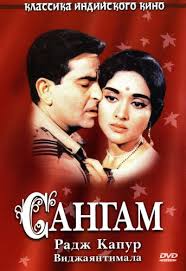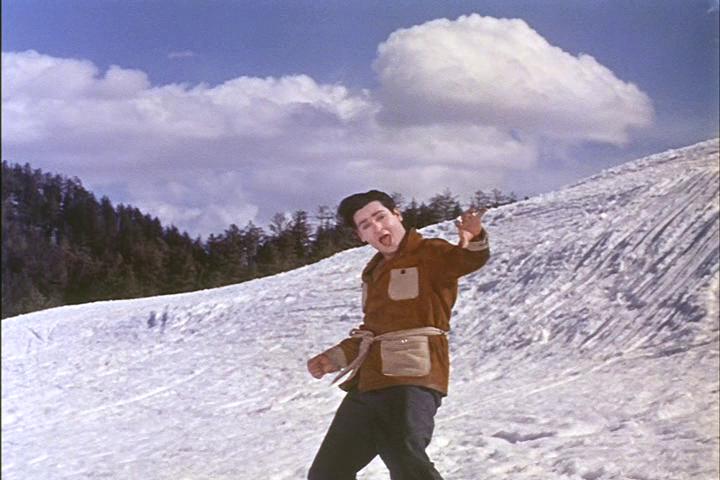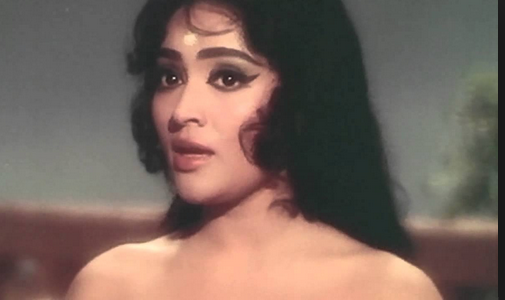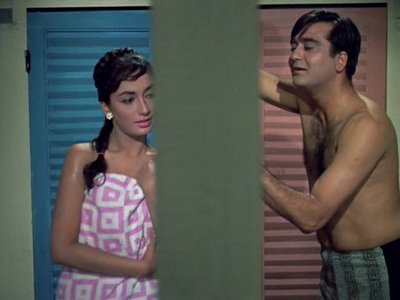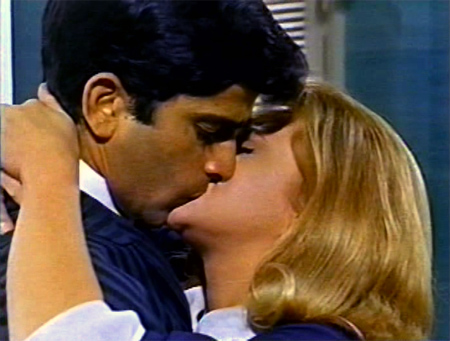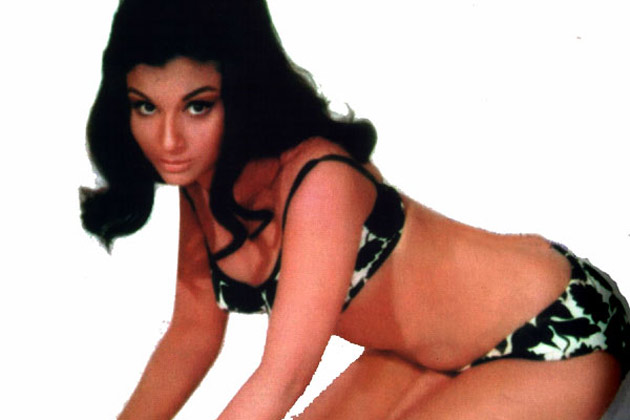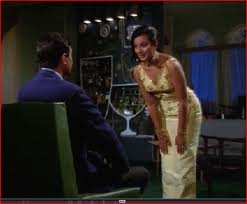Hindi-Urdu cinema: 1960-69
Readers can send additional information, corrections, photographs and even
complete articles on new subjects to our Facebook page Indpaedia.com. If found suitable, this additional information will be incorporated into the Indpaedia article (with an acknowledgement) and new entries will be created (also with due acknowledgement). Readers will be able to edit existing articles and post new articles directly on Indpaedia.com only after its formal launch. |
The 1960s by h2g2 and Indianetzone
The 1960s would introduce further changes in 'Bollywood' as black and white films would gradually be replaced by colour, and would feature the first superstar in a long time, Rajesh Khanna.
The 1960s saw some major changes taking place in Bollywood and these included filming in foreign countries and more memorable songs and music.
Aradhana
Released in 1969, this film told a story of a handsome young Indian Air Force Pilot, 'Arun', who falls in love with a doctor's daughter, 'Vandana'. The two get married in a temple and he returns to his duties, but before he can marry Vandana officially he is killed in an outbreak of conflict. Vandana learns that she is pregnant, but Arun's parents reject her as their daughter-in-law. She then gives birth to a son, and puts him up for adoption. But then her maternal instincts take over and she finds the family who have adopted him, taking a job as his nanny. Living under the same roof, she gets unwanted attention from a male family member, who attempts to rape her.
The little boy witnesses the incident and kills the attacker. Vandana takes the blame for murder and is sent to prison, but upon her release she is informed by the warden that her son's family have moved. The warden offers her a job to look after his daughter, who is in love with an Indian Air Force Pilot who looks similar to Arun, who, Vandana later finds out, is her own son.
Aradhana received three filmfare awards (Indian equivalent to the Academy Awards), which included Best Song for 'Roop Tera Mastana' by Kishore Kumar, Ashok Kumar's youngest brother. Rajesh Khanna didn't receive any awards for Aradhana but it made him into a superstar. Wherever he went he would be mobbed, mostly by female fans. His popularity began to increase to an amount that had not been seen before. During the filming of Amar Prem (Immortal Love), (not released until 1971), there was scene that needed to be filmed at Howrah Bridge in Calcutta. A boat carrying Rajesh Khanna and his co-star Sharmila Tagore was required to go under this bridge.
However, the authorities ruled this scene out as they realised that if the public found out that the hero of the film would be there, it may create problems on the bridge itself, and even that it might collapse due to the amount of people trying to get a glimpse of their favourite actor. It was then decided that a set would be erected inside the studio, with a fullsize replica of the Howrah Bridge. Rajesh Khanna's popularity was to last until well into the 1970s, when he would be overtaken by another actor, Amitabh Bachchan.
Chaudvin Ka Chaand (1960)
A Guru Dutt, Waheeda Rehman, Rehman starrer, the film was a big musical success due to its unique love story. It brought an altogether different shade of romance to the Indian audience.
One of the first films to be released in the early 1960s was Guru Dutt's Chaudvin Ka Chand (The Moon of the Fourteenth) with Waheeda Rehman, but because his previous movie had been a disaster and he was no longer directing, this one was directed by M Sadiq. The title song, with the playback by Mohd Rafi, was the only one performed in colour. The only other song that was in colour was 'Pyar kiya to darna kya' ('If you are in love, then why are you scared') from the Mughal-E-Azam, which was released in the early 1960s. This was an indication that colour was slowly being introduced but it would be some time before it would be completely phased in as it was expensive to do this at the time.
Dosti (1964)
The film by Rajshree Productions surprised everyone as it was made on a shoe-string budget and featured newcomers, Sushil Kumar and Sudhir Kumar in the lead. But the characterisation by director Satyen Bose and excellent music by Laxmikant Pyarelal made it a big commercial success.
Ganga Jamuna (1961)
Dilip Kumar for the first time dabbled in producing a dacoit film and also featured himself in the lead. The Technicolor film was a big commercial success due to a classic performance by Vyjayantimala and music by Naushad.
Guide (1966)
The Pathecolor film was an Indo-US co-production (certainly the first Indian co-production with a foreign country) and was made in Hindi and English (bilingual versions in Hindi and English are at least as old as Raj Nartaki/ Court Dancer of 1941). The Vijay Anand-directed film was based on a story by RK Narayan and was a big commercial success partly due to a few melodious numbers. (The film was released in 1966, never mind what most websites say.)
Jis Desh Mein Ganga Behti Hain (1960)
The film may well be said to be the first to propagate the evils of dacoity. The film also started a trend for the dacoity subject on the Hindi screen. Featuring Raj Kapoor and Padmini in the lead and it conveyed allegorically an important message of love and brotherhood.
Kanoon (1960)
What made the murder mystery strikingly different from the run of the mill fare of the decade was the fantastic performance by Ashok Kumar and the court room drama which was never witnessed before in any films.
Meena Kumari
Meena Kumari, whose real name was Mahajabeen Bano, was born on 1 August, 1932, to Ali Baksh and Iqbal Begum. Though she wanted to go to school, she started to work in films at the age of seven, effectively becoming the family breadwinner. The film that made her a household name was Vijay Bhatt's, Baiju Bawra (Baiju is Mad), released in 1952. It starred actor Bharat Bhushan in the lead role as 'Baiju'. Meena Kumari was also known as 'The Tragedy Queen' because of the characters she portrayed in films such as 'Chhoti Bahu' in Sahib Bibi Aur Ghulam.
In the 1960s she worked on some of the most memorable films such as Kohinoor (Diamond) (1960), Dil Ek Mandir (Heart is a Temple) (1963) and Kaajal (1965). However, it was while filming in 1952 that she fell in love with the director, a married man, Kamal Amrohi, who was 15 years older than her. Soon after they got married, she produced a film entitled Daera, based on her and Kamal Amrohi's love story. Amrohi and Meena Kumari also planned another black and white film, Pakeezah, but it was not released until 1972 and when it was, it was in complete colour. Noticeably, there were parts of the film where she looked much younger than in others.
Due to their strong personalities, the marriage to Kamal Amrohi fell apart in 1960 and the two got divorced in 1964. Though they did re-marry, it was too late because she abused alcohol and had become similar to her character in Sahib Bibi Aur Ghulam — a complete alcoholic. She also relied on intimate relationships with her younger male colleagues such as Dharmendra, who had acted with her in Kaajal. Though Meena wrote some poetry and was considered an Urdu poet, she drowned her senses with alcohol. Three weeks after the 1972 release of Pakeezah, which opened to a lukewarm public viewing at the Box Office, Meena Kumari became seriously ill with cirrhosis of the liver and on 31 March, 1972, she passed away.
Mughal-E-Azam (1960)
The most ambitious film ever, it took more than 8 years for K Asif to complete the film however it never lost its charm when released unlike other delayed films and was a big box-office success. The historical subject and soul stirring music by Naushad were the major highlights.
Mujhe Jeene Do (1963)
Sunil Dutt started off from where Raj Kapoor left with a film on dacoity. The success of this film made many filmmakers to rush towards the Chambal ravines for a film on the lives of dacoits. The film also starred Waheeda Rehman and Mumtaz.
Padosan (1968)
How far Mehmood dominated the cast as a comedian was never more visible than when he took on the likes of Sunil Dutt, Kishore Kumar, Sairo Banu, Mukri and Keshto in this film. It was a big hit and the song Chatura Naal.. became a rage.
Rajesh Khanna
As the 1960s was coming to an end, another star rose to fame. He would go on to be the first superstar ever since KL Saigal and this was Rajesh Khanna. Born Jatin Khanna, in the North Indian city of Amritsar in the state of Punjab in 1942, he was soon orphaned and was adopted. He joined the industry in the 1960s after winning an 'All India Talent Contest' and went on to make his acting debut in a film entitled Aakhri Khat (The Last Letter). But it was Shakti Samantha's film, Aradhana (Sacrifice) that really turned him into a romantic hero as well as one of the most sought-after stars.
Sahib Bibi Aur Ghulam
In 1962 Guru Dutt released another well known movie of his - Sahib Bibi Aur Ghulam (The Gentleman, the Wife and the Servant) - in which he again starred with Waheeda Rehman, his friend Rehman, Johnny Walker and Meena Kumari. The film was directed by his assistant, Abrar Alvi.
A low caste, educated man reaches the city of Calcutta seeking employment. He witnesses the colonial rulers looting stores and also notices that the old feudal system is decaying and a new one is coming into existence. The man, Atulya Chakraborthy, also known as 'Bhoothnath' (Ghostly-looking one), finds employment in a mansion which belongs to an immoral landlord family who have fallen on hard times. The bride of the youngest son, known as 'Chhoti Bahu' (Young daughter-in-law), gains his attention as she seeks solace, while her husband gets involved with dancing girls, squanders the family fortune and is drinking heavily. Soon Bhoothnath is forced to leave and years later, when he returns, he finds a skeleton in the ruins of the mansion and is informed that the skeleton is that of Chhoti Bahu, and that she had been murdered.
After the disaster of Kaagaz Ke Phool, Guru Dutt was so devastated and disgusted that he wanted to quit but was unable to do so due to financial constraints. When Sahib Bibi Aur Ghulam was being planned, he refused to act and the role of Bhoothnath was offered to Raj Kapoor's youngest brother Shashi Kapoor, who turned it down, as did another well known actor, Biswajeet. Guru Dutt eventually took on the role himself.
Dutt's first choice for the female lead role of Chhoti Bahu was Nargis, who was by now married to actor Sunil Dutt (no relation to Guru Dutt), who Guru Dutt had previously dropped from one of his earlier films. But it didn't materialise and the role went to Meena Kumari, an alcoholic. The other problem that Guru Dutt faced was that his affair with Waheeda Rehman had wrecked his marriage, and his wife Geeta Dutt refused to sing for Meena Kumari in the film. But the movie went on to become a success; today it is known as one of Guru Dutt's best films, as well as a classic which portrays one of the greatest characters on the screen.
Sangam (1964)
The year 1964 witnessed a major change in Bollywood in more ways than one. Raj Kapoor released his film Sangam (The Confluence). It was the first Indian film to be filmed outside India--in France and Switzerland. It also was also the first colour (Technicolour) film by Raj Kapoor who, by then, had become India's biggest Movie Mogul, in terms of the budgets of his films and their commercial success. This heralded the beginning of the end of the black and white era in Hindi-Urdu cinema. After that perhaps only two black and white films in Hindi-Urdu were major commercial success--Dosti and Saheli, though Haqeeqat and Shaheed had huge cult followings, especially among nationalistic urban youths.
A lower class boy, Sunder, is friends with upper class boy, Gopal and also with a girl, Radha. As the three grow up, Sunder and Gopal fall in love with Radha but she loves Gopal, who, unlike Sunder, is not able to tell her that he loves her. To overcome his problems of being a lower class person, Sunder joins the Air Force and is soon required to go into action, but during this, his plane is shot down and he is considered missing. In the meantime, Gopal gathers courage to write an unsigned love letter to Radha and one day, as they are planning to get married, they receive the news that Sunder is alive and is returning home as a hero. Soon Sunder and Radha get married and go on their honeymoon to Europe, where, after he receives an invitation from Sunder, Gopal also joins them. But in order not to ruin her marriage to Sunder, Radha asks him to go and forget their relationship and friendship. He leaves them and returns home.
One day, after they return to India, Sunder, unaware of the request made by Radha to Gopal, informs his wife that he bumped into Gopal but when he called him, he was ignored. But soon Gopal and Sunder meet again and this time the friend is invited to dinner. The story takes a twist as Sunder begins to think that Radha is being unfaithful to him, and he finds the unsigned love letter from Gopal. Sunder talks to Gopal about his thoughts and suspicions, and Gopal is unable tell him that Radha isn't being unfaithful, and doesn't inform him that the unsigned love letter was from him to her. This leads to tragedy when Gopal takes his own life, after he reveals the truth to his friend.
The film starred a very young Randhir Kapoor, who plays the part of the 'younger Sunder'. The film's location and photography, along with the songs, were considered to be one of the best. One particular song that is still considered as most haunting and emotional is 'Dost dost na raha, pyar pyar na raha' ('I have no friend and I have no love'), sung by Mukesh for his friend, Raj Kapoor. While listening to the song at the time of the recording, Raj Kapoor, who was producing, editing and directing this movie under his own banner, had tears in his eyes. The emotions shown in the film as the song is sung are real. Raj Kapoor had always said that Mukesh was his voice when singing in films. This song hit the target with the audience as many had tears in their eyes, and it still has the power today when they hear the song on TV or DVD. There were other songs as well such as 'Mein Kya karoo Ram mujhe budha milgaya' ('What do I do lord, I am married to an old man'), sung for the actress Vyjayantimala by the nightingale of India, Lata Mangeshkar. The other was 'Yeh Mere Prem Patra' ('My Love Letter') for the actor Rajendra Kumar by Mohd Rafi.
Sangam, being a love triangle story, had an ending that audiences love, and it is considered to be one of the best Raj Kapoor films. It is remembered for its filming on locations in Switzerland and France, the acting, the story, the directing, the songs and the music. But besides this, Raj Kapoor was able to portray his fascination with sexuality in more than one scene. But what really gained momentum in the story and which came across very well were emotions. The actors used their facial expressions in such a way that it made the audience feel those emotions.
Saraswati Chandra (1968)
This film by director Govind Sariya became a sucess due to a solo stupendous effort by Nutan and some very good songtracks by music directors Kalyanji-Anandji.
Shammi Kapoor
With black and white films being slowly phased out, the Industry saw India have its own 'Yahoo' before the event of the Internet and the famous search engine. This was in the form of Shammi Kapoor, who was considered to be India's Elvis Presley because of his looks and his style of dancing. The second son of Prithviraj Kapoor and Raj Kapoor's younger brother, Shamsher Raj Kapoor was born on 21 October, 1931. Shammi was noticed when Nasir Hussain released his film Tumsa Nahin Dekha, but it was Dil Dekhe Dekho (Look and See With Heart), which was released in 1959, that earned him the image of a light-hearted playboy. The one film that attached the nickname 'Yahoo' to him was Junglee (Wild One), which was directed by Subodh Mukherjee and released in 1961. This was the biggest hit of the year and had one song, sung by Mohd Rafi for Shammi Kapoor, 'Chahe Koi Mujhe Junglee Kahe' ('Let anyone call me the wild one'), which began with the word 'Yahoo'.
One thing for sure was that Shammi Kapoor's image was similar to that of Elvis Presley, and this could be seen in the 1966 movie Teesri Manzil, which was directed by Dev Anand's brother, Vijay Anand, known to many as 'Goldie'. This film featured two of the most popular songs at the time. The first, 'O Haseena Zuflon Wali', had the sensational Helen as Shammi Kapoor's dancing partner and a very catchy tune. If any films in those days did not have Helen dancing to a catchy tune, the audience would consider it an unworthy song. But in almost every film that Shammi Kapoor acted in, there would be at least one song in which Helen would make an appearance as his dancing partner. The second song, 'Aaja aaja mein hoon pyar tera' ('Come here, I am your lover'), had the lead actress, Asha Parekh, as Shammi Kapoor's dancing partner. The song had dance beats and the steps were that of twist along with a catchy tune. During the filming of this movie, tragedy struck when Shammi Kapoor's wife, Geeta Bali, passed away. Shammi Kapoor later romanced another actress — his co-star in the 1968 movie, Brahmachari. This relationship failed, and a year later he married again. His career as a leading actor soon began to fizzle out as he began to put on weight, and his last film as a hero, Andaz, starring the actress Hema Malini, was released in 1971. Shammi Kapoor has gone on to work on many films and it is only now (2009) that he has started to use a wheelchair as his health has begun to deteriorate.
Upkaar (1967)
The film was an excellent portrayal of Indian rural life and Manoj Kumar buttered it with his usual dose of patriotism. Pran`s performance was highly acclaimed and some very good music made it a big success at the box-office.
Waqt
The mid-1960s saw another change being introduced in Bollywood films and that was what many consider to be Hollywood-style influence and also the luxurious, deliciously dissolute lifestyle of the rich kids in Mumbai (Bombay). This was clearly shown in the film Waqt, (Time), which was directed by Yash Chopra and released in 1965.
A rich family, consisting of a father, his wife, and their three sons, are split up after an earthquake. The father tries to find his family, when he is informed that one of his sons has been physically abused in an orphanage. He then murders the warden at the orphanage in an act of revenge, and is sent to prison for 20 years. In the meantime the three sons, who now live separately, grow up. One becomes a lawyer, the second a burglar, and the youngest is at college. Still living at home with his mother and struggling, in order to survive, the youngest son takes up employment as a chauffer to a criminal.
This film had a multi-star cast: Balraj Sahni, Raaj Kumar, Shashi Kapoor, Achala Sachdev, Sadhana, Sharmila Tagore, Madan Puri, Rehman and Sunil Dutt. It featured a song which became very popular and is still remembered today, 'Ai Meri Zohrajabeen', sung by Manna Dey for Balraj Sahni, who sings to his wife, played by Achala Sachdev. The song, which was recorded in mono with the other songs, was later briefly sung by actor Amrish Puri in the 1990s super hit film Dil Walleh Dulhaniya Lejayenge (One With The Big Heart Will Take The Bride) to his wife, Farida Jalal. Amrish Puri's mother's role was played by Achala Sachdev. The other song, that is still remembered today and one which moved the story along, was 'Aage bh jaane tu' ('You don't know what the future holds'), a solo tune sung by Lata Mangeshkar's sister, Asha Bhonsle.
BR Chopra, the producer, was fond of the Golden Age of Hollywood but was unable to get the cast to work on a weekly wage. Instead it was on start to finish schedule. The film was extensively shot in the studio which had pink and blue walls, fountains in the bedrooms, circular beds, mirrored ceilings, uniformed chauffeurs, sports cars and motor boats — the sort of style that had never been seen by the general public.
Success at the box office
Year-wise rankings adapted from Ibos
See IbosNetwork for
a) A list of 50 films per year. Ibos has arranged the first 20-odd according to box office success, and the remaining in the alphabetical order;
b) The date when the film was released;
c) ‘Raw’ collections (i.e. actual rupees earned in that year);
d) Adjusted Collections (i.e. the rupees earned at 2013 prices and size of market).
1960: the top Hindi-Urdu hits
Rank Film Name
1. Mughal E Azam
2. Barsaat Ki Raat (1960)
3. Kohinoor
4. Chaudhvin Ka Chand
5. Jis Desh Mein Ganga Behti Hai
6. Love In Simla
7. Bewaqoof
8. Ghunghat (1960)
9. Kala Bazaar
10. Kanoon
11. Chalia
12. Hum Hindustani
13. Parakh
14. Bambai Ka Babu (1960)
15. Singapore
16. College Girl (1960)
17. Sarhad (1960)
18. Manzil (1960)
19. Ek Phool Char Kante
1961: the top Hindi-Urdu hits
Rank Film Name
1. Ganga Jamuna
2. Junglee
3. Jab Pyaar Kisi Se Hota Hai (1961)
4. Gharana
5. Hum Dono
6. Sasural
7. Aas Ka Panchhi
8. Sampoorna Ramayan
9. Kabuliwala
10. Zindagi Aur Khwab
11. Nazrana (1961)
12. Jhumroo
13. Maya
14. Shola Aur Shabnam (1961)
15. Pyar Ka Sagar
16. Reshmi Roomal
17. Chhaya
18. Roop Ki Rani Choron Ka Raja (1961)
19. Piya Milan Ki Aas
20. Boy Friend (1961)
21. Chhote Nawab
22. Saaya
1962: the top Hindi-Urdu hits
Rank Film Name
1. Bees Saal Baad
2. Professor
3. Ek Musafir Ek Haseena
4. Hariyali aur Raasta
5. Asli Naqli
6. Dil Tera Diwana (1962)
7. Aarti
8. China Town
9. Sangeet Samrat Tansen
10. Anpadh (1962)
11. Sahib Bibi Aur Ghulam
12. Half Ticket
13. Naughty Boy
14. Son Of India
15. Dr Vidya
16. Main Chup Rahungi
17. Baat Ek Raat Ki
18. Prem Patra
19. Shadi
20. Sautela Bhai
21. Soorat Aur Seerat
1963: the top Hindi-Urdu hits
Rank Film Name
1. Mere Mehboob
2. Gumraah
3. Dil Ek Mandir
4. Taj Mahal
5. Tere Ghar Ke Saamne
6. Mujhe Jeene Do
7. Shikari (1963)
8. Gehra Daag
9. Bahurani (1963)
10. Bandini
11. Hamrahi
12. Aaj Aur Kal
13. Phool Bane Angare
14. Bluff Master
15. Parasmani (1963)
16. Dil Hi To Hai (1963)
17. Kinare Kinare
18. Akeli Mat Jaiyo
19. Nartaki
1964: the top Hindi-Urdu hits
Rank Film Name
1. Sangam
2. Dosti
3. Aayee Milan Ki Bela
4. Raajkumar
5. Woh Kaun Thi
6. Ziddi (1964)
7. Haqeeqat
8. Kashmir Ki Kali
9. April Fool
10. Samson
11. Zindagi (1964)
12. Beti Bete
13. Dulha Dulhan
14. Chitralekha
15. Leader
16. Door Ki Awaz
17. Jahan Ara
18. Phoolon Ki Sej
19. Pooja Ke Phool
20. Shabnam (1964)
21. Aap Ki Parchhaiyan
22. Sharabi
1965: the top Hindi-Urdu hits
Rank Film Name
1. Waqt
2. Aarzoo
3. Himalay Ki God Mein
4. Guide (was released in 1966)
5. Gumnaam
6. Jaanwar (1965)
7. Jab Jab Phool Khile
8. Khandaan
9. Mere Sanam
10. Shaheed (1965)
11. Kaajal
12. Sikandar E Azam
13. Johar Mehmood In Goa
14. Bheegi Raat
15. Bahu Beti (1965)
16. Teen Deviyan
17. Bedaag
18. Neela Akash
19. Oonche Log (1965)
20. Chand Aur Suraj
1966: the top Hindi-Urdu hits
Rank Film Name
1. Phool Aur Pathar
2. Suraj
3. Mera Saaya
4. Love in Tokyo
5. Teesri Manzil
6. Do Badan
7. Pyaar Kiye Jaa
8. Aye Din Bahar Ke
9. Sawan Ki Ghata
10. Dus Lakh
11. Amrapali
12. Jadoo
13. Aasra
14. Dil Diya Dard Liya
15. Ladka Ladki
16. Mamta (1966)
17. Neend Hamari Khwab Tumhare
18. Yeh Zindagi Kitni Haseen Hai
19. Saaz Aur Awaz
20. Anupama
21. Devar (1966)
1967: the top Hindi-Urdu hits
Rank Film Name
1. Upkaar
2. Farz
3. Hamraaz
4. Ram aur Shyam
5. Jewel Thief
6. Shagird
7. An Evening in Paris
8. Patthar Ke Sanam
9. Aag (1967)
10. Aamne Saamne
11. Around The World
12. Aman
13. Night in London
14. Ram Rajya
15. Meharbaan
16. Dil Ne Pukara
17. Palki
18. Raaz (1967)
19. Ghar Ki Chirag
20. Chandan Ka Palna
21. A Night In London???? (twice?)
1968: the top Hindi-Urdu hits
Rank Film Name
1. Aankhen (1968)
2. Do Kaliyan
3. Neel Kamal
4. Raja aur Rank
5. Kanyadaan
6. Padosan
7. Aadmi
8. Brahmachari (1968)
9. Sathi
10. Shikar (1968)
11. Duniya (1968)
12. Haseena Maan Jayegi (1968)
13. Gauri
14. Kismet (1968)
15. Mere Huzoor
16. Saathi (1968)
17. Jhuk Gaya Asmaan
18. Sungursh
19. Man Ka Meet (1968)
20. Mere Humdum Mere Dost
21. Sadhu Aur Shaitan
1969: the top Hindi-Urdu hits
Rank Film Name
1. Aradhana
2. Do Raaste
3. Ek Phool Do Mali
4. Jeene Ki Raah
5. Shatranj (1969)
6. Waaris
7. Prince
8. Inteqaam
9. Milan [Indpaedia is certain there was no such film in 1969)
10. Saajan (1969)
11. Bandhan (1969)
12. Jigri Dost
13. Doli
14. Aaya Sawan Jhoom Ke
15. Talash
16. Ittefaq (1969)
17. Yakeen
18. Chirag
19. Pyar Hi Pyar
The top hits of the 1960s: according to BoxOfficeIndia
See BoxOfficeIndia
Rank Film Year
1 Mughal E Azam 1960
2 Sangam 1964
3 Ganga Jamuna 1961
4 Mere Mehboob 1963
5 Upkar 1967
6 Waqt 1965
7 Aradhana 1969
8 Aankhen 1968
9 Do Raaste 1969
10 Jab Jab Phool Khile 1965
11 Phool Aur Patthar 1966
12 Ram Aur Shyam 1967
13 Suraj 1966
14 Ayee Milan Ki Bela 1964
15 Farz 1967
16 Himalay Ki God Mein 1965
17 Mera Saaya 1966
18 Ek Phool Do Mali 1969
19 Hamraaz 1967
20 Dosti 1964
21 Barsaat Ki Raat 1960
22 Arzoo 1965
23 Junglee 1961
24 Teesri Manzil 1966
25 Taj Mahal 1963
26 Shagird 1967
27 Ziddi 1964
28 Guide 1965 (wrong; 1966 is the correct year)
29 Do Kaliyan 1968
30 Kohinoor 1960
31 Prince 1969
32 Love In Tokyo 1966
33 Bees Saal Baad 1962
34 Phir Wohi Dil Laya Hoon 1963
35 Jewel Thief 1967
36 Neel Kamal 1968
37 Rajkumar 1964
38 Inteqaam 1969
39 Jaanwar 1965
40 Milan 1967 (correct year)
41 Chaudvin Ka Chand 1960
42 Do Badan 1966
43 Kanyadaan 1968
44 Gharana 1961
45 Khandaan 1965
46 An Evening In Paris 1967
47 Ek Musafir Ek Haseena 1962
48 Jeene Ki Raah 1969
49 Gumrah 1963
50 Kashmir Ki Kali 1964
See also
CinemaScope films in Bangladesh, India, Nepal, Pakistan, Sri Lanka 70mm films in India/ South Asia Cinerama theatres in India, Pakistan, Sri Lanka 3D films in South Asia Colour films in South Asia Colour films in India Colour films in Hindi-Urdu
Hindi-Urdu cinema: 1930-39 Hindi-Urdu cinema: 1940-49 Hindi-Urdu cinema: 1950-59 Hindi-Urdu cinema: 1960-69 Hindi-Urdu cinema: 1970-79 Hindi-Urdu cinema: 1980-89 Hindi-Urdu cinema: 1990-99 Hindi-Urdu cinema: 2000-09 Hindi-Urdu cinema: 2010-19
Indian cinema: historical outline Covers the era before the first Indian feature filmIndian cinema: 1913-20 Indian cinema: 1920-29 Indian cinema: 1930-39 Indian cinema: 1940-49 Indian cinema: 1950-59 Indian cinema: 1960-69 Indian cinema: 1970-79 Indian cinema: 1980-89 Indian cinema: 1990-99 Indian cinema: 2000-09 Indian cinema: 2010-19



